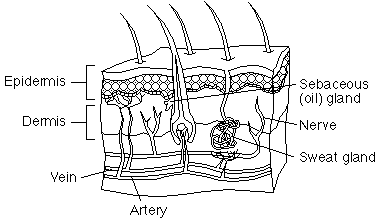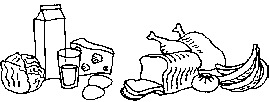Maintaining Healthy Skin
What is healthy skin?
Your skin is much more than an outer surface for the world to see. It protects you from bacteria, dirt and other foreign objects and the ultraviolet rays of the sun, and contains the nerve endings that let you know if something is hot or cold, soft or hard, sharp or dull. Your skin also plays an important role in regulating your body’s fluids and temperature.
Below the smooth, hairy outer skin, or epidermis, that we see every day is a thick, strong and elastic layer of tissue known as the dermis. The dermis is richly supplied with blood vessels, sweat and oil glands, and nerve endings.
Healthy skin is smooth, with no breaks in the surface. It is warm (not hot or red) and neither dry and flaky nor moist and wrinkled. Healthy skin is a mirror of a healthy body.
How to take care of your skin:
 NUTRITION:
NUTRITION:
To keep your skin healthy, eat a well-balanced diet that includes plenty of protein foods, fruits and vegetables (fresh if possible) and liquids. If you are having a skin problem, such as a pressure sore or a healing surgical incision, you should increase your intake of protein (lean meats, dairy foods and legumes), carbohydrates (breads, cereals), vitamins A, C and E, and zinc. Extra iron may be needed if you are anemic (see “Anemia” paragraph below).
 CIRCULATION:
CIRCULATION:
The skin is served by a large number of blood vessels, and adequate circulation is needed to maintain skin health. You can help ensure a healthy blood supply by considering the following suggestions:
- Smoking – DON’T! Nicotine in cigarettes causes blood vessels to get small (constrict) and prevents blood, oxygen and nutrients from flowing to the body tissues.
- Edema , or swelling caused by fluid collecting in the tissues, usually occurs in a part of the body that is not moved frequently and is below the level of the heart (i.e., the feet, legs and hands). Skin over areas of edema becomes thin and pale and injures easily because of poor circulation. Edema can be prevented by elevating your legs and hands frequently, performing regular Range of Motion (ROM) exercises and wearing compressive stockings.
- Anemia (a decrease in red blood cells). Oxygen is essential for skin health, and is carried by red blood cells. A decrease in their number means less oxygen gets to the skin, which means that skin cells may become unhealthy or even die. Anemia should be evaluated and treated by your health care provider.
- Vascular Disease , or a narrowing of the blood vessels, can be caused by diabetes, smoking, high blood pressure or elevated cholesterol. The result is decreased blood flow to the skin. Work closely with your health care provider to manage conditions that can lead to vascular disease and cause skin problems.
Tips for maintaining good skin care:
-
Avoid soaps labeled “antibacterial” or “antimicrobial.” These tend to reduce the skin’s acidity, which acts as a protection from infection.
-
Keep the skin clean and dry. Wash with soap and water daily, then rinse and dry thoroughly.
-
Skin folds or creases (as in the groin area and underarms) need washing more frequently – twice a day, morning and bedtime. Rashes can easily form in these areas because of increased moisture and warmth. Increasing the air circulation to these areas to help prevent rashes can be accomplished by positioning the arms and legs so the skin surfaces are separated. For example, use the “frog” position to air the groin area. Air these areas two times a day.
-
Rashes can be caused by tapes, soaps, fabrics or other irritants. Total body rashes may result from food or drug allergies. Consult your health care provider for treatment of these and any other rashes you may have.
-
Avoid using items that may dry the skin – for example, harsh soaps or alcohol based products such as lotions. (A good non-drying lotion to use is Alpha Keri.)
-
Lubricate dry skin with moisturizing creams or ointments (such as Eucerin or Aquaphor). Use care in applying creams over bony areas, since they may soften the skin and promote skin breakdown.
-
Soiled skin can break down easily. Urine and stool have irritants in them and should be cleaned up immediately to prevent weakening and breakdown of the skin surface.
-
Avoid using talc powders, as they may support yeast growth. They can also “cake up” and keep moisture in, causing skin breakdown.
-
Calluses may form on your feet and hands. These can be removed by soaking frequently in warm water and toweling briskly to remove dead skin. You can use moisturizing creams to help soften calluses. Note that calluses may indicate an area of excess friction or pressure.
- Finger and toe nails require special care. Soak them and rub gently with a towel to remove dead skin and decrease the chance of hangnails forming. Nails are easier to cut after soaking; be sure to cut them straight across to avoid ingrown nails, and keep them short for safety. If ingrown nails develop, see your primary care provider or podiatrist.
University of Washington-operated SCI Clinics:
Harborview Medical Center
Rehabilitation Medicine Clinic
325 9th Ave., Seattle WA 98104
Spinal Cord Injury Clinic nurses: 206-744-5862
University of Washington Medical Center
Rehabilitation Medicine Clinic
1959 NE Pacific, Seattle WA 98195
Spinal Cord Injury Clinic nurses: 206-598-4295
[Download this pamphlet: “Maintaining Healthy Skin: Part 1” – (PDF, 518KB)]
